Seeing your competitors at the top of the Google Search results can be frustrating, but with the right SEO tools, you can see exactly what they are doing to rank at the top of Google’s organic search results. There are tools that will help you identify the type of technical structure that they have implemented, as well the content that they have developed to rank the site successfully. What is most influential is knowing the type of links that point to their site to rank at the top of the organic search results. What is even better is knowing where to find and how to acquire those links.
You can achieve this by using Ahrefs. It’s been a popular tool amongst those in the SEO community. Once you know how to use the tool, you will be able to find hidden link opportunities and be in a position to build links to your website at scale.
We’re going to show you how our agency Digital Next finds quick win linking opportunities for our clients using Ahrefs, and how you can do the same thing for any website that you want to build links to.
Recommended: What are the SEO Trends for 2018 Likely to Be?
Contents
Discover the backlinks that your competitors already have
You can place in your competitor’s domain and it will provide you with a list of the URLs that are linking back to their website.
You can filter the URLs by groups or one link per domain. I’d suggest doing one link per domain as it is easier to analyse and prospect the links quickly.
You can then filter the linking domains from the highest authority to the lowest using domain rating (also known as DR).

You can then go through the list of links and open a link in another tab. You can then assess the links to see if they are relevant and their linking process. Some of the websites will clearly indicate that you can add a link to their website, submit content or submit a guest post. Others may have a list of resources or links and you will need to contact them directly to see if they will consider adding your link to the page.
Recommended: 6 SEO Link Building Methods
Identifying popular content opportunities
People link to content because they like the value that the content offers. One approach is to brainstorm and create new content opportunities that may generate links. Another easier approach is to find content that people are already linking to and create a better version of that particular piece of content.
You can use Ahrefs to see what content is the most linked to on a website. You can then do a lookup to see how many sites are linking to that content.
You want to make sure the topic associates with one niche audience. You will then be able to build your your prospect list to scale.
Aim to build a prospect list of at least 100. This should give you a good probability of getting links to your website. The typical success rate in a link building campaign is 1-2%. However, with this approach you can get a 10% response rate or even higher. Additionally, the links tend to go on more authoritative web pages.
In the example below, you can see the links going back to this site.
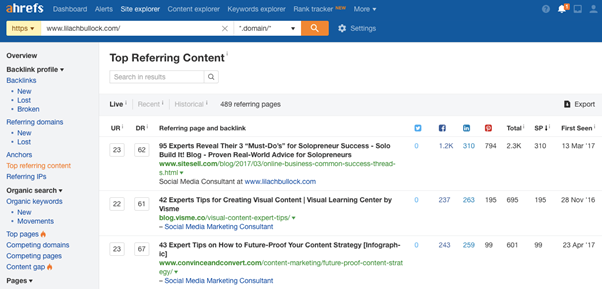
You can then lookup the source of the links to see the type of content that they are producing. It is clear to see that “roundup” style posts are contributing to their link acquisition success.
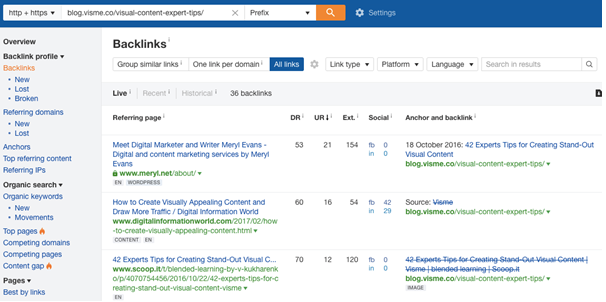
If you can see that this is the type of content that people are linking to in your industry, you can create content or even cite the people who are known to link to the content in a roundup stype post.
Identifying broken link building opportunities
Some of the most powerful links that you can get for your website are from broken link building opportunities. Domains go offline everyday and there are URLs that continually change, causing 404 errors. Many of the website owners linking to those sites are unaware that they are linking to a broken resource page.
With Ahrefs, you can see if a website has any broken links and you can then do a search on those broken URLs to see if there are any sites linking to them.
If there are, add them to your prospect list and make a note of the content that they are linking to.
Once you have content that is similar (if not better) than the one of the broken link resource, send an email to them and pitch to have your site’s link added to the website.
Below is a result from one website showing a list of sites that have linked back to content that now displays a 404 error. In the example, there are 60 broken links. So that is potential 60 linking opportunities.
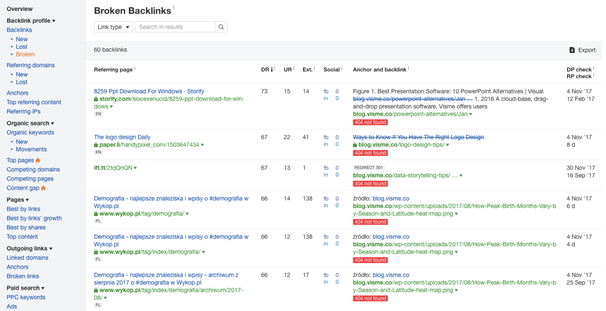
Closing 10% of these would give you 6 links from relevant and authoritative web pages. The beauty with broken link building is that you can reach out to the website owner or manager and demonstrate immediate value by alerting them to a problem on their site, and then providing an instant solution with a link to your content. It is a win-win for both parties involved.
Anchor text analysis
The anchor text refers to the words that are used in the hyperlink. You will be able to see a pattern of with their anchor text footprint. Use this to identify if competitors were able to rank using branded, exact match or partial match anchor text.
You can even see the category of the link.
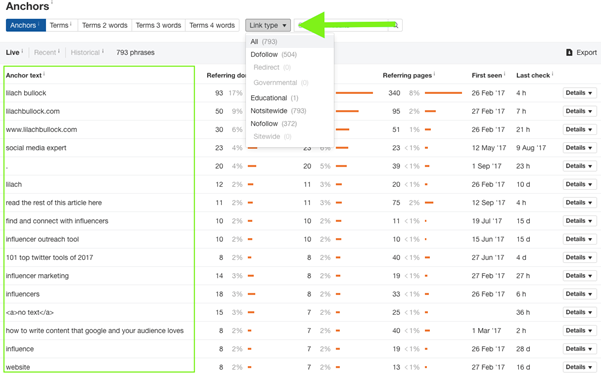
You can also use this tool to see if sites are engaged in any practices against Google’s terms of service
One of the biggest problems on the web is having people pay for links on websites. It’s an issue that Google is working hard to overcome and they have issued penalties on websites in the past if they feel that the site has too much excessive external linking.
Red flags for this type of activity can usually be spotted by putting a domain into Ahrefs and seeing how many external links are going from the site and whether they are relevant and if they have a similar pattern of using exact match anchor text.
In the image below, you can see an example of a website that has several hundred outbound links and is likely to be involved in paid link schemes. You want to minimise the chances of your site ending up on one of these sites in case you get your site penalised.
How to use Ahrefs and Snov.io
So, you’ve found the websites and are ready for link building. To remain the professional and cut down the time of reaching out to the website admins, it’s better to take advantage of emails. For this purpose, you will need to use a tool that will find necessary email addresses. Try Snov.io email finder. It works properly on any webpage and provides you with all the email IDs associated with it.
Just add the extension from the Chrome Web Store, and activate it on any webpage clicking the extension icon. The tool will provide you with all the emails available on the page.
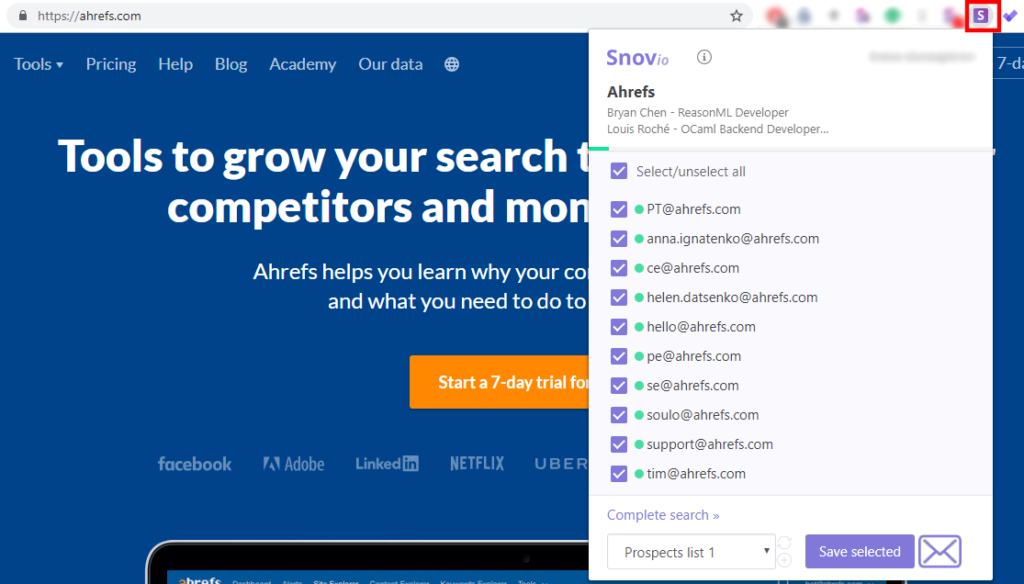
Then, you can go one of two ways.
Step #1: Write to people right from the extension. Simply choose people, click the Send email button, compose the email and the subject line, and click the Send email button.
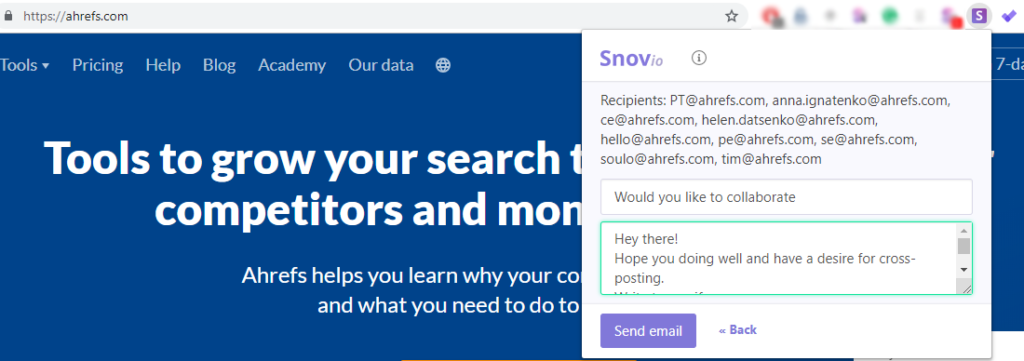
Step #2: Save their email addresses and send a triggered email sequence with Snov.io Drip Campaigns tool.
Activate the extension icon, choose email addresses to be saved, click the Save selected button. After that, go to the Snov.io main page and Log In (Sign Up if you have no account; note: the tool is free).
Go to the web application, tab Campaigns (click the New drip campaign button). Create an email sequence. You can add triggers and set delays, personalize the subject line and the message body, use Snov.io email templates or your own ones, attach files and links and track them.
The email sequence may look like this:
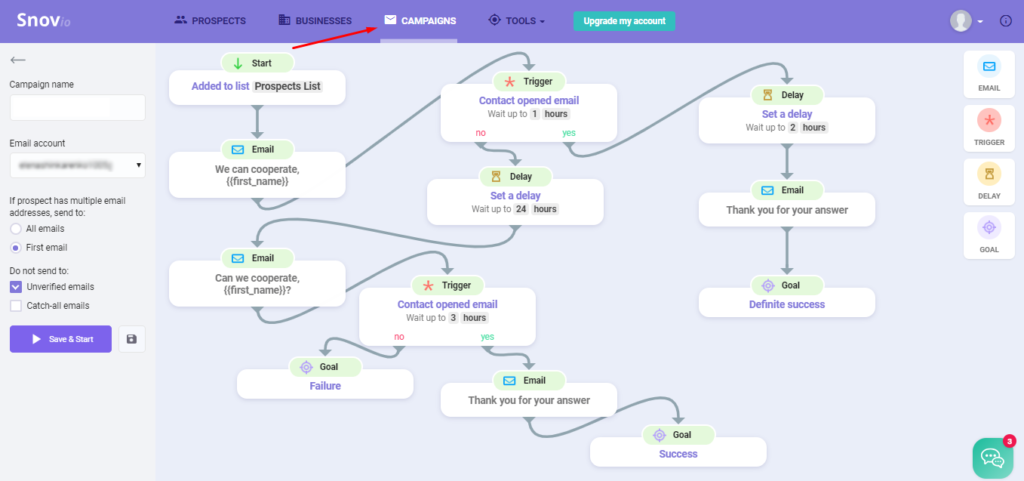
Send the campaign, follow the statistics, and be ready for the quick answers.
